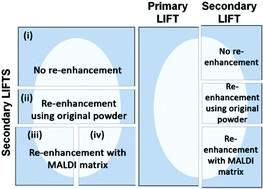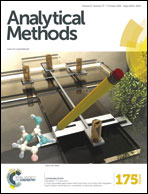Development of operational protocols for the analysis of primary and secondary fingermark lifts by MALDI-MS imaging†
Abstract
Eight years of intensive research have demonstrated that Matrix Assisted Laser Desorption Ionisation-Mass Spectrometry Profiling and Imaging (MALDI-MSP and MSI) are powerful tools to gather intelligence around a suspect lifestyle, directly from the identifying ridges of a latent fingermark. In the past three years, many efforts have been invested into translating laboratory methodologies to the field; this was undertaken by devising protocols either for (a) enabling initial fingermark visualisation, such as through the Dry-Wet method, recovery and subsequent MALDI MS based analysis, or for (b) rendering the MS methodologies compatible with the prior application of commonly employed fingermark enhancement techniques (FET). In the present work a major point of interest concerned the sample treatment of FET visualised-lifted fingermarks and the subsequent MS performance of primary tape lifted fingermarks (“primary lifts”) versus secondary tape lifted fingermarks (recovery from the surface a second time following the initial primary lift). This was necessary since it may not always be possible to obtain primary lifts of marks visualised at crime scenes for remote MALDI-MSP and MSI. The work illustrated here has provided methodological insights into establishing how to best treat a few types of developed marks in preparation for MALDI-MSI when presented as both secondary and primary lifts; it was demonstrated, as expected, that primary lifts generally yield much higher quality chemical/physical information and are therefore crucial to maximise chances of suspect identification and of retrieval of chemical intelligence. When analysing secondary lifted marks that have been initially developed using aluminium or carbon powders, any of the trialled sample preparation methodologies can be employed except the Dry-Wet method. In the case of TiO2 powder developed marks, the best ridge coverage was achieved by re-enhancing the mark using the initial powder and spray-coating with MALDI matrix. Primary lifts of fingermarks contaminated with an exogenous substance (used as a reference model) yielded the best ridge detail quality whilst for secondary lifts of natural marks pre-enhanced with aluminium powder, significantly greater intensity of the ion image was observed for the sections subjected to either no further enhancement or re-enhancement using aluminium powder.


 Please wait while we load your content...
Please wait while we load your content...